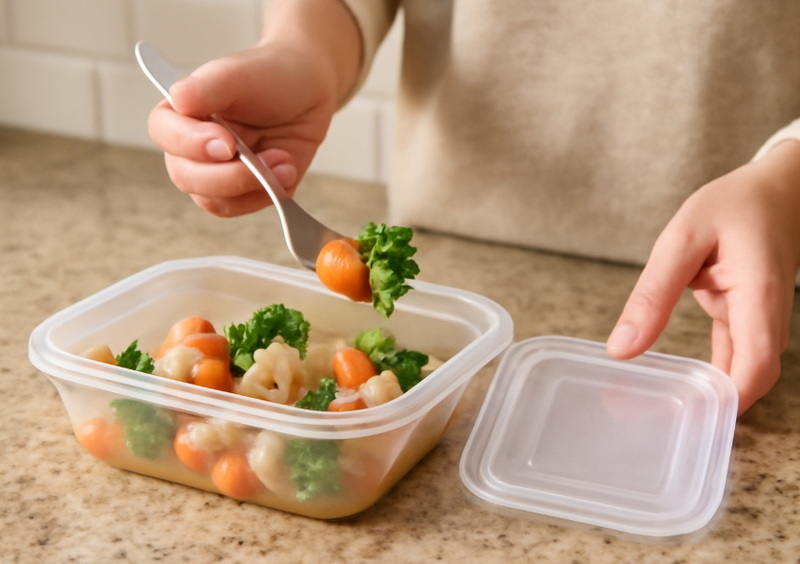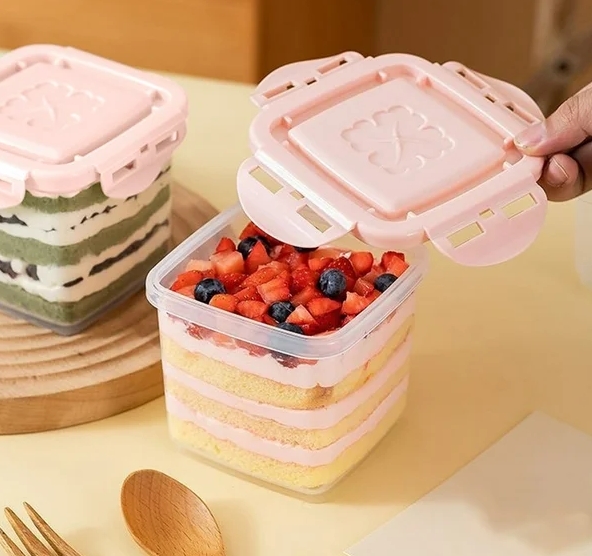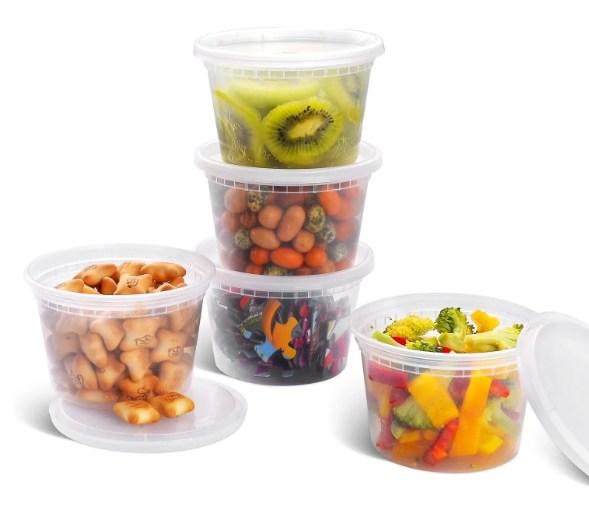
Content Menu
● Understanding Disposable Containers With Lids
>> What Are Disposable Containers With Lids?
>> Types of Disposable Containers With Lids
● Are Disposable Containers With Lids Freezer-Safe?
>> Material Considerations
>> How to Test Freezer Safety
● Best Practices for Freezing Food in Disposable Containers With Lids
>> 1. Choose the Right Container
>> 2. Ensure a Tight Seal
>> 3. Portion Food Appropriately
>> 4. Cool Food Before Freezing
>> 5. Label Everything
>> 6. Avoid Overfilling
>> 7. Store Properly in the Freezer
● Advantages of Using Disposable Containers With Lids for Freezing
● Potential Drawbacks and How to Address Them
>> 1. Brittleness and Cracking
>> 2. Freezer Burn
>> 3. Environmental Impact
>> 4. Not Suitable for All Foods
● Tips for Thawing and Reheating Food from Disposable Containers With Lids
● Common Foods to Freeze in Disposable Containers With Lids
● How to Prevent Freezer Burn When Using Disposable Containers With Lids
● Environmental Considerations
● Conclusion
● Frequently Asked Questions (FAQ)
>> 1. What makes a disposable container with lid freezer-safe?
>> 2. Can I freeze food in paper-based disposable containers with lids?
>> 3. How do I prevent freezer burn when using disposable containers with lids?
>> 4. Is it safe to reheat food in disposable containers with lids?
>> 5. Can I reuse disposable containers with lids after freezing food?
Freezing food is a time-honored method for extending freshness, reducing waste, and ensuring you always have a meal ready when life gets busy. As the demand for convenience grows, more people are turning to disposable containers with lids as a solution for storing and freezing food. But is it truly safe and effective to freeze food in these containers? What are the best practices to ensure quality and safety? This comprehensive guide explores the ins and outs of using a disposable container with lid for freezing food, offering practical advice, safety tips, and answers to the most common questions.

Understanding Disposable Containers With Lids
What Are Disposable Containers With Lids?
A disposable container with lid is a single-use or limited-use storage solution designed for food. These containers are typically made from materials such as plastic, aluminum, bagasse (plant fiber), or coated paper. The attached or separate lid is meant to seal the contents, keeping food fresh and preventing spills. These containers are popular for takeout, meal prepping, catering, and storing leftovers.
Types of Disposable Containers With Lids
There are several types of disposable containers with lids, each with unique properties:
- Plastic containers: Often made from polyethylene or polypropylene, these are lightweight, moisture-resistant, and sometimes microwave-safe.
- Aluminum containers: Durable and versatile, aluminum containers can handle both hot and cold foods and are commonly used for freezing casseroles or baked dishes.
- Bagasse containers: Made from sugarcane fiber, these compostable containers are sturdy, eco-friendly, and suitable for freezing.
- Coated paper containers: These are sometimes used for short-term storage but are generally less suitable for long-term freezing due to their vulnerability to moisture.
Are Disposable Containers With Lids Freezer-Safe?
Material Considerations
Not every disposable container with lid is suitable for the freezer. The most important factors to consider are:
- Temperature resistance: The container and lid must withstand freezing temperatures without becoming brittle or cracking.
- Moisture resistance: To prevent freezer burn and preserve food quality, the container should resist moisture vapor.
- Seal integrity: A tight-fitting lid is essential to keep air out and prevent leaks.
Plastic containers labeled as freezer-safe, aluminum trays, and bagasse containers generally perform well in the freezer. Standard paper-based containers, unless specifically coated or laminated for freezing, are prone to moisture damage and should be avoided for long-term use in the freezer.
How to Test Freezer Safety
If you're unsure whether your disposable container with lid is freezer-safe, perform a simple test: fill the container with water or food, freeze it for a day or two, and check for brittleness, cracking, or leakage. Reliable suppliers often provide temperature range information and product documentation for their containers.
Best Practices for Freezing Food in Disposable Containers With Lids
1. Choose the Right Container
Select containers specifically labeled as freezer-safe. Opt for containers made from polyethylene, polypropylene, aluminum, or bagasse for best results. Avoid large containers for freezing fruits and vegetables, as slow freezing in large volumes can degrade quality.
2. Ensure a Tight Seal
Always use containers with secure, snap-tight lids to minimize air exposure. For extra protection, wrap the container in plastic film or use freezer tape if the lid is not airtight.
3. Portion Food Appropriately
Freeze food in portion-sized containers to avoid thawing more than needed at once. Shallow containers or spreading food in a thin layer can help speed up the freezing process and preserve texture.
4. Cool Food Before Freezing
Allow hot food to cool to room temperature before placing it in the container. This prevents condensation, which can cause freezer burn and compromise the seal.
5. Label Everything
Clearly mark each disposable container with lid with the food type, freezing date, and recommended use-by date. This helps with inventory management and ensures food is used within its optimal quality period.
6. Avoid Overfilling
Leave a small space at the top of the container to allow for food expansion as it freezes. Overfilling can cause lids to pop off or containers to crack.
7. Store Properly in the Freezer
Stack containers neatly to maximize freezer space and prevent crushing. Place heavier items at the bottom and lighter ones on top.

Advantages of Using Disposable Containers With Lids for Freezing
- Convenience: No need for cleaning or returning containers, especially useful for meal sharing or events.
- Portion control: Easily freeze single servings for quick meals.
- Stackability: Uniform shapes make organizing the freezer simple.
- Reduced cross-contamination: Single-use containers minimize the risk of lingering odors or flavors.
- Time savings: Meal prep and storage become more efficient with ready-to-use containers.
Potential Drawbacks and How to Address Them
1. Brittleness and Cracking
Some disposable containers with lids, especially lower-quality plastics, may become brittle and crack at low temperatures. To reduce this risk, choose containers labeled as freezer-safe and avoid sudden temperature changes.
2. Freezer Burn
Improper sealing or air exposure can lead to freezer burn, affecting taste and texture. Always ensure lids are tightly closed and consider double-wrapping for extra protection.
3. Environmental Impact
Single-use containers contribute to waste. When possible, select compostable or recyclable options, such as bagasse or aluminum, and recycle appropriately after use.
4. Not Suitable for All Foods
Some foods, like those with high moisture content, may expand significantly when frozen. Use containers with enough headspace and avoid freezing foods in containers that are too large, as this can slow down the freezing process and degrade quality.
Tips for Thawing and Reheating Food from Disposable Containers With Lids
- Thaw in the refrigerator: This is the safest method and helps maintain food quality.
- Avoid reheating in plastic containers unless labeled microwave-safe: Some plastics may release chemicals or warp under heat.
- Do not refreeze thawed food: This can compromise both safety and texture.
- Remove the lid before microwaving: If the container is microwave-safe, always remove the lid or vent it to prevent pressure build-up.
Common Foods to Freeze in Disposable Containers With Lids
- Soups and stews: Portion into single servings for easy lunches.
- Cooked grains and pasta: Freeze in meal-sized portions.
- Casseroles and baked dishes: Use aluminum trays with lids for easy reheating.
- Fruits and vegetables: Use shallow containers to speed up freezing.
- Sauces and purees: Freeze in small containers for quick use in recipes.
How to Prevent Freezer Burn When Using Disposable Containers With Lids
Freezer burn occurs when air comes into contact with the food's surface, causing dehydration and oxidation. To prevent this:
- Use containers with tight-fitting lids.
- Remove as much air as possible before sealing.
- Double-wrap with plastic film or use freezer bags for extra protection.
- Freeze food quickly to minimize the formation of large ice crystals.
Environmental Considerations
While disposable containers with lids offer convenience, they also raise environmental concerns. To minimize your impact:
- Choose compostable or recyclable options whenever possible.
- Reuse containers if they remain intact and clean after use.
- Avoid over-reliance on single-use plastics by incorporating reusable containers for non-gifting or in-home storage.
Conclusion
Freezing food in a disposable container with lid is a practical, convenient solution for meal prep, leftovers, and food storage. By choosing the right type of container, ensuring a tight seal, and following best practices for freezing and thawing, you can preserve food quality and safety with minimal hassle. While there are environmental considerations to keep in mind, opting for compostable or recyclable containers can help reduce your impact. With proper use, a disposable container with lid can be a valuable tool in your kitchen, making it easier than ever to enjoy delicious, home-cooked meals anytime.

Frequently Asked Questions (FAQ)
1. What makes a disposable container with lid freezer-safe?
A disposable container with lid is considered freezer-safe if it is made from materials that can withstand low temperatures without becoming brittle or cracking, and if it provides a tight seal to prevent air and moisture from entering. Common freezer-safe materials include polyethylene, polypropylene, aluminum, and bagasse. Always check for labeling or manufacturer specifications to confirm freezer safety.
2. Can I freeze food in paper-based disposable containers with lids?
Standard paper-based containers are not recommended for freezing, as they lack moisture resistance and may degrade or become soggy in the freezer. However, wax-coated or laminated paper containers can be used for short-term freezing, but they may still break down over time. For best results, use plastic, aluminum, or bagasse containers specifically designed for freezer use.
3. How do I prevent freezer burn when using disposable containers with lids?
To prevent freezer burn, always use containers with tight-fitting lids, remove as much air as possible before sealing, and consider double-wrapping the container with plastic film for extra protection. Label and date your containers, and use frozen food within a reasonable timeframe to ensure optimal quality.
4. Is it safe to reheat food in disposable containers with lids?
It is safe to reheat food in a disposable container with lid only if the container is labeled as microwave-safe. Remove the lid or vent it before microwaving to avoid pressure build-up. For oven reheating, only use aluminum containers, as most plastic containers are not suitable for oven use.
5. Can I reuse disposable containers with lids after freezing food?
While disposable containers with lids are designed for single or limited use, you can reuse them if they remain intact, clean, and undamaged after the first use. However, repeated freezing and thawing may weaken the material and compromise the seal, so monitor the condition of the container before reusing.

















